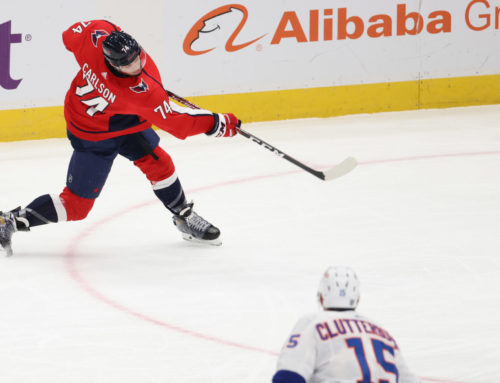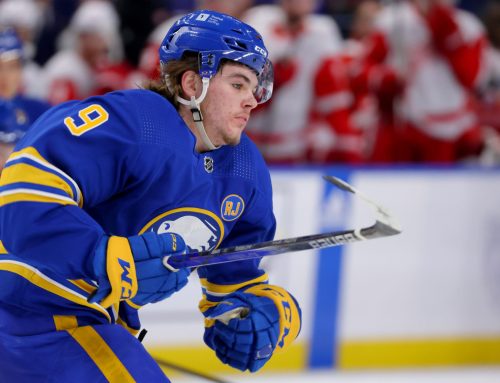
Both the Draft and Free Agency are behind us which means there really isn’t a whole lot left to do this offseason. There is still the possibility of offer sheets but let’s face it, NHL general managers are more concerned with getting a Christmas card from a rival than improving their own team. Were that not the case, the Jets, Wild, and Senators would have a lot of questions with what to do about Jacob Trouba, Jason Zucker, Matt Dumba, and Mark Stone.
Besides the pipe dream of offer sheets, what’s left? A quick rundown.
We’ve seen the reports of a low-ball contract offer, and potential a trade, so it seems increasingly unlikely that Karlsson returns in an Ottawa uniform. I wrote a bit more on the landing spot for Karlsson at the bottom of these Ramblings.
The latter name seems an absolute lock to be traded, though we thought it may have happened by now. Is Justin Faulk still gong to be sent out, though? With the signing of Calvin de Haan (more on that here from Dobber), maybe they see Faulk as a luxury to use in sheltered minutes on the third pair? Let him soak up secondary PP minutes behind Dougie Hamilton. Maybe not. We’ll see.
Anything more from Vegas?
The Golden Knights lost both James Neal and David Perron but did add Paul Stastny. They have been linked to both John Tavares (obviously not an option now) along with Erik Karlsson. Do they still make a push for EK65?
With the uncertainty from Rick Nash, the biggest name left in unrestricted free agency seems to be Patrick Maroon. We’ve seen his upside in recent seasons when given a good centre to play with (well, a generational centre in his case), with 44 goals, 85 points, 168 PIMs, and 339 hits over the last two years, most of which was in Edmonton. Is there a team with an elite centre who still needs a left winger? The only team that comes to mind is Pittsburgh and they’re pretty close to the cap. It’ll be interesting to see where Maroon lands because in the right situation, he can be an excellent multi-category performer.
There is still some intrigue to the offseason with significant fantasy implications, though we’re all waiting for that EK65 shoe to drop.
*
Yesterday on Twitter a follower asked me the best way to evaluate a goalie for fantasy hockey. It’s a good question with a bad answer.
The truth is there’s no real consensus way to evaluate goaltending for fantasy hockey. The old adage is Goaltending Is Voodoo and while that’s an oversimplification, it’s not far from the truth. Pekka Rinne was mostly bad for a few years and then just had a Vezina-winning season. Carey Price looked to be the top goaltender of a generation and then was abysmal in 2017-18. Tuukka Rask strung together several great seasons consecutively before being a bit more average for a few years now. Mike Smith has one season in his career with a save percentage above .916 and it was .930 (!) in 2011-2012. We can go on and on with examples like this.
While some of those goalies have injury histories, we don’t know how much or how little it hurt them. There are other goalies like Quick and Halak with a mix of great and terrible years.
Scouting goaltenders is one thing, projecting them for fantasy usefulness in a given year is a whole other ballgame. The way I go about it, particularly goalies without a meaningful sample of work, is team context. Can they limit shots? Can they limit high-danger shots? What’s their penalty kill like? Do they have a high-scoring team that can help give some goal support for wins? These factors are crucial for fantasy value. Weird things happen every year with goaltending (Carter Hutton and Marc-Andre Fleury just this past year for example) but taking the team into account is a must. I get into this a bit more just below.
*
I was talking with a friend on mine on Twitter yesterday (hi, Pari!) and the conversation revolved around Robin Lehner going to the Islanders. I had tweeted a day earlier about Lehner having the same save percentage over the last three years as Tuukka Rask (it’s true, he does) and being surprised all Lehner could get out of that was a one-year deal for $1.5-million. That’s not an accurate representation of the talent level of either player but rather a surprise that solid boxcar stats couldn’t lead to a better contract. But I digress.
Here’s what I found when it comes to high-danger shots against percentage and low-danger shots against percentage between Rask and Lehner over the last three years (data from Corsica and you can read the primer on HDSA and LDSA here):
the answer might surprise you! pic.twitter.com/8LufzBfiZ9
— Michael Clifford (@SlimCliffy) July 4, 2018
Basically, if you look at the columns to the right, Lehner actually saw a lower rate of high-danger shots against out of total shots faced at five-on-five than Rask did. Given the disparity in the quality of the two teams over the last three years, most wouldn’t think that to be the case.
The caveat, of course, is that Buffalo allowed a lot more shots; in that span, the Sabres had a shots-against per 60 minutes rate of 31.43 (sixth-worst) compared to Boston’s 27.83 (third-best). Given how close their high-danger shots against rates are, it makes sense that their overall save percentages would be close. The disparity in goals against average is a function of total shots faced, which is why Lehner’s was 2.77 from 2015-18 and Rask’s was 2.39.
That got me thinking about a recent free agent: Petr Mrazek.
Surely, given how bad Detroit’s blue line is and has been for the last few years, that Mrazek may have been asked to make an extra few spectacular saves, right? That was indeed the case. Here are the five goalies with the highest high-danger shots against as a percentage of total shots faced. It’s over the last four seasons, at five-on-five, with a minimum of 7500 minutes played:

(side-bar here: poor Henrik Lundqvist)
There are 17 games mixed in there for the Flyers but the vast majority of the games came with Detroit and that is a lot of high-danger shots to face. Now, Detroit was a team that slowed down the pace of the game so their actual volume of shots was about the middle of the league but they did give up a very high rate of dangerous shots.
One would think that going to Carolina would help, right?
Just below the cut-off of that picture of highest percentage of high-danger shots faced, the next name after Corey Crawford, is Cam Ward’s.
The difference between Carolina and other teams we see on that list like the Islanders, Rangers, and Blackhawks is that Carolina didn’t allow a lot of shots in that span. In fact, from 2014-18, the Hurricanes allowed the fourth-fewest total shots per 60 minutes at five-on-five, while the Rangers allowed the 6th-most, the Islanders the 8th-most, and the Blackhawks the 9th-most.
Carolina has been able to upgrade defensively since the season ended. Dougie Hamilton is an upgrade on Noah Hanifin and Calvin de Haan is just an upgrade, period. With Jaccob Slavin and Brett Pesce, that is a very stout top-4 defenceman. Will a new coach and upgrades on the defensive end help? We’ll find out next year.
All this is to say that the environment upgrade for Mrazek is real but it may not be as significant as it seems on the surface. There is a lot more to dig into before the season gets here but I just wanted to point out that blindly saying that Carolina’s team context will be a big boost for Mrazek’s numbers isn’t quite right. He may not even get a lot of starts.
*
I suppose some people might be wondering which goalies faced the lowest rate of high-danger shots against? Here are the four goalies with lowest rate of HDSA% over the last four years (the fifth goalie was Ben Bishop but he’s played across three different teams so I excluded him):

Anyone who plays daily fantasy hockey already knew this (or should have known this) about Devan Dubnyk. There’s a reason why he’s popular in the DFS community: few dangerous shots against. It also helps put Pekka Rinne’s performance into context. Having such a good defence in front of you is nice to have.
The name that stuck out to me was Roberto Luongo. It’s a pretty good performance from Florida defensively as a team and if Luongo can stay healthy maybe he can be a steal in drafts this September? That may be a lot to ask in his age-39 season, though.
*
Rumours came out late Tuesday night that the Dallas Stars were frontrunners in landing Erik Karlsson. It was reported by both Chris Stephenson and Sean Shapiro of The Athletic, the former an Ottawa writer and the latter in Dallas.
Two things came to mind immediately: this would be great for the Stars and this would be horrific for John Klingberg’s fantasy value.
Last year, Klingberg had 170 more minutes on the power play than the next-closest Dallas defenceman, which is a long way of saying they used, mostly, a 4F1D top PP unit. Up front, they used Tyler Seguin, Alexander Radulov, and Jamie Benn along with Klingberg, and then mixed in guys like Jason Spezza, Devin Shore, Brett Ritchie, and others. In fact, about 45 percent of their PP combinations had the Big Four along with one of those guys.
That led me to this thought: why would it necessarily be bad for Klingberg’s fantasy value? Obviously, the introduction of a future Hall of Fame puck-moving defenceman at just 28 years old might cut down on Klingberg’s PP touches, but is it for certain it would push him off the PP altogether? It’s clear that no one combination of forwards worked give how much other players were mixed in. Maybe instead of Karlsson replacing Klingberg, relegating the younger Swede to the second unit, Karlsson just replaces [Insert Random Forward Here] instead?





 MTL
MTL
 PIT
PIT FLA
FLA S.J
S.J MIN
MIN CGY
CGY L.A
L.A ARI
ARI
